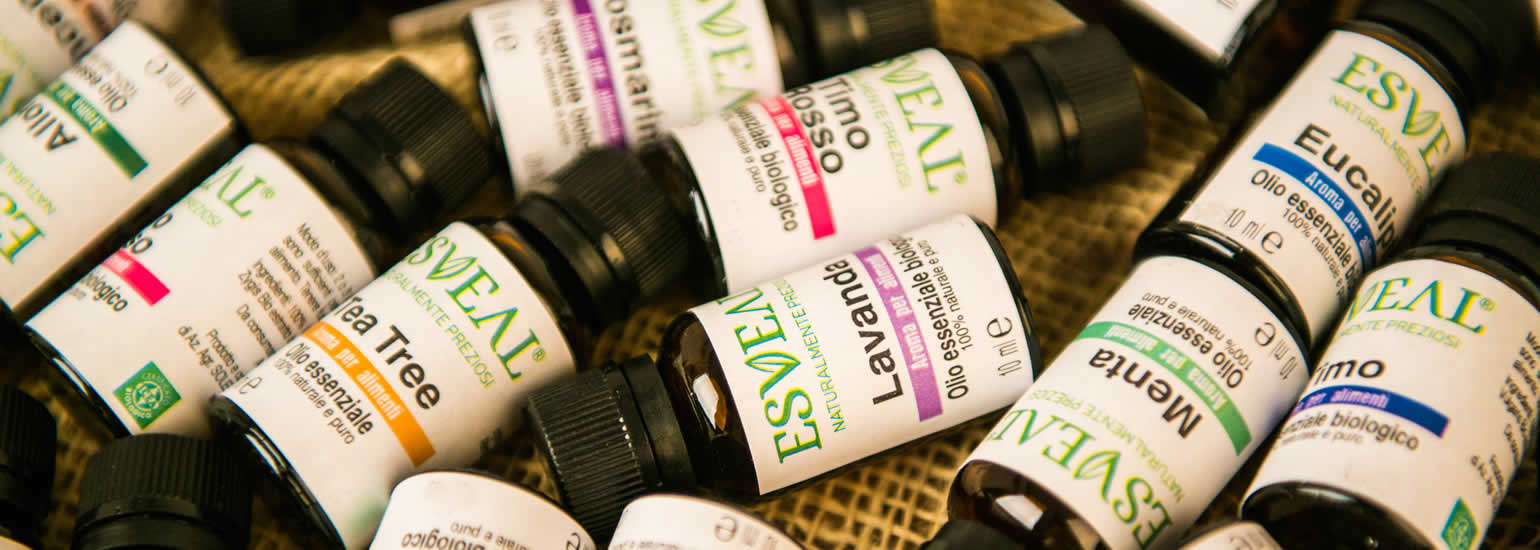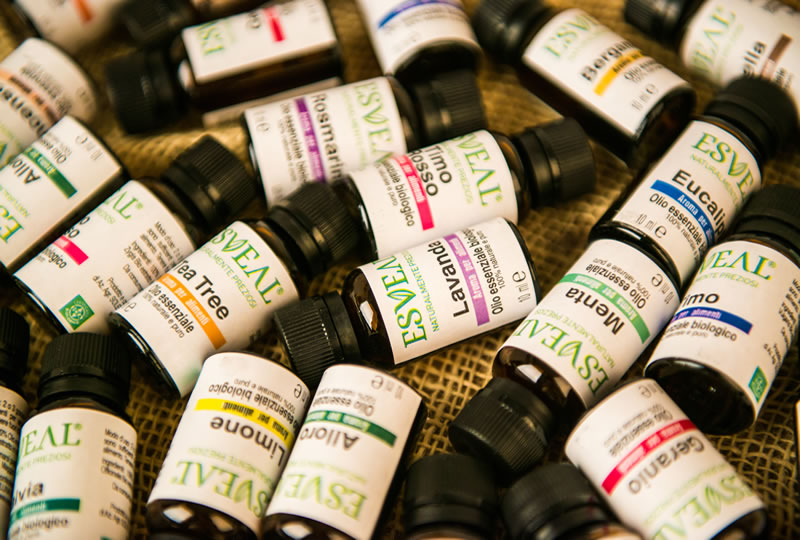
ORGANIC ESSENTIAL OILS
EUCALYPTUS, LAVENDER, LEMON, ROSEMARY, SAGE, THYME.
EUCALYPTUS, LAVENDER, LEMON, ROSEMARY, SAGE, THYME.

.
Related Topics : Good conservation practices for essential oils - characteristics of essential oils - Aromatic waters - Methods of extraction of essential oils - Organic essential oils - Essential oils and astrological functions - Essential oils and olfactory notes - Eucalyptus essential oil - lavender essential oil - lemon essential oil - rosemary essential oil - sage essential oil - thyme essential oil - Operational practice in the extraction of essential oils - Purification and rectification of essential oils - Yield in the extraction of essential oils - Use of essential oils
How can we not be taken by admiration and pervaded by humility when we discover, through research and experiments, even complex ones, how much our ancestors were right in their many indications and in their way of using plants and Essential Oils? In general, we have nothing to add to what they handed down to us in this field. We simply confirm, acknowledge that they were right. It is to be expected that a day will come when the full value of natural therapies will be increasingly recognised. Future generations will be amazed at certain theories and teachings concerning health in force today, in the same way that we are amazed at the treatment of scabies in use in the 18th and 9th centuries, with its bloodlettings and purges designed to facilitate the elimination of bad moods or the treatment of syphilis, which has made the disease itself more dead, with mercury. All Essential Oils can be used for external use, to massage the skin diluted in an emollient oil, or in the bathtub or in vaporizers to perfume the environment. For their use it is important to remember that they are very concentrated substances that should never be used pure, but diluted, avoiding contact with eyes and mucous membranes. If you expose yourself to the sun's rays, you must bear in mind that some Essential Oils have photo-sensitizing properties and there is a risk of skin reactions such as burns and blisters. Their extraordinary versatility is such that they can be used in the most convenient form: external applications, inhalation, compresses, hand baths (including half-cups) and foot baths, hair rinses, inhalations through steam, sprays and room diffusers. There are countless commonly used Essential Oils but a family can satisfy their hypothetical needs with about ten of them. Due to their richness in terpenes and phenols, as well as in alcohol and aldehydes, natural Essential Oils, after the discovery of their constituents, have always been considered to have antiseptic properties. For millennia, their bactericidal action has been confirmed in fact. Among the Essential Oils most used for their antiseptic properties, we mention eucalyptus, eugenia, niaouli, thyme, garlic, sandalwood, lemon, cinnamon, lavender, mint.
- Essential Garlic Oil is used as a preventive measure during influenza epidemics and as a modifier of bronchial secretions.
- The Essential Oil of eugenia kills the tuberculosis bacillus and is used in dental surgery as a disinfectant and cauterizer even if, in this field, it is increasingly being replaced by its main constituent Venganol.
- Sandalwood Essential Oil is a specific oil for the disinfection of the urinary tract. Other effective disinfectants of the urinary tract are the Essential Oils of juniper, lavender etc..
- Essential Thyme Oil is an excellent antiseptic undoubtedly thanks to the thymol it contains. By way of indication, Essential Thyme Oil has an antiseptic and antiparasitic power definitely superior to that of hydrogen peroxide or potassium permanganate.
The antiseptic properties of Essential Oils are used daily and advantageously by the housewife who uses garlic, thyme, lemon, clove and other aromas in her culinary preparations. Aromatic sauces, for example, often owe their digestive properties to their essences. They include cinnamon, clove, aniseed, cumin, chervil, chervil, parsley, nutmeg, vanilla, estragon, saffron, bay leaves, savory, rosemary, thyme, which are used in convenient quantities and are perfectly tolerated by the intestine. Because of their antiseptic properties, the Essential Oils can be classified in the following descending order:
- intensely active : pine, lavender, thyme, eucalyptus, niaouli
- very active: basil, eugenia, hyssop, sassafras
- medium/low active: lemon, fennel, walnut, burdock.
Essential Oils can be administered in various ways, orally, alone or in combination, usually in the form of pills or drops in an alcoholic solution; externally, especially for suffumigias, inhalations, liniment, general or local baths. Some recent studies have demonstrated the absorption through the skin of the mineral and vegetable principles introduced in the baths and found in the blood. This discovery explains the action of aromatic baths, thyme for example, or pine needle, on the lungs (antiseptic, mucous membrane fluidifier, expectoration aid). These baths certainly act by inhalation of vapours but also through blood, since the essences follow the path: skin - blood - lungs. The aromatic essences are therefore among the most effective products to be used in the baths. These effects of extraordinary diffusibility of the Essential Oils, allow us today to give a logical explanation to those ancient practices that consisted in hanging a small bag containing some garlic cloves around the neck of children affected by worms. This method was also used to prevent epidemic diseases. The antiseptic power of the Essential Oils is all the more precious because their aggressiveness towards microbial germs is associated with their harmlessness towards tissues. The antiseptic power of Essential Oils does not diminish, nor does it diminish over time. Many Essential Oils, in addition to their antiseptic and bactericidal properties, have antiviral properties.
The antiseptic properties of Essential Oils are complemented by a remarkable healing power on burns. This property, encountered especially in labiatae (lavender, sage, rosemary, thyme...) will be used to heal flaying, banal sores, infected, atone, leg ulcers, fistulas. Skin diseases sometimes benefit from a treatment based on Essential Oils. The antiparasitic properties of Essential Oils have also been known for centuries. The Essential Oils of lavender, geranium, oregano... keep away insects, moths, mosquitoes and their application gives excellent results in the treatment of insect bites, wasps, mosquitoes and spiders. In the absence of Essential Oils in bottles, an excellent treatment for these bites is to rub them with lavender flowers, rosemary, sage leaves, a leek cut in half, a piece of onion or garlic. The pain quickly disappears and the inflammation subsides in a few minutes. Do not neglect to remove the sting that may have remained under the skin. These Essential Oils neutralize the insect venom. Many Essential Oils have anti-nevralgic and anti-rheumatic properties for local applications in the form of emulsions, ointments, liniment, or tablets. The Ancients knew this, using applications of baked plants or poultices of garlic, onion, thyme, sage... in painful rheumatic and gouty diseases. The properties of Essential Oils vary by species. Since all of them affect many disorders, it is impossible to classify them according to their therapeutic properties.
They are antiseptics (pulmonary, intestinal, urinary...), antifermentative, detoxifying, remineralizing, stimulating and antispasmodic, diuretics, anti-rheumatic, aperitifs, digestive, carminative, febrifuge, cholagogues, vermifuge. Most of the Essential Oils have hormonal properties, which act on corticosurrenals, ovaries, thyroid... Some are aphrodisiacs, suitable to "rehabilitate organs worn out by age or dried up by vice", others are antidiabetics, vaso-dilators or vasoconstrictive. Antiseptic Essential Oils (pulmonary, intestinal, urinary...) include lemon, thyme, lavender, gomenol (niaouli), turpentine, pine, eucalyptus, eugenia, etc... Almost all of them should be mentioned.
Rosemary promotes bile production and its evacuation. The essential oils of lavender, mint, sage, thyme are also choleretic.
They hinder the formation of gallstones or urinary calculi: garlic, lemon, juniper, hyssop, nutmeg, onion.
They have antispasmodic properties lavender, marjoram, verbena, cypress, aniseed.. .
A few drops of Essential Extragon Essential Oil laid on the tongue will make the hiccups pass instantly.
They quickly stop a spasmodic cough a few drops of Essential Cypress Oil in the ear.
Lavender calms the excitability of the nervous system.
The detoxifying power of Essential Oils will also be used daily to combat the many food poisonings that affect many people..
Garlic, onion, aniseed, lemon, lemon, juniper, thyme are antifermentatitvi. It is not to be forgotten how much intestinal infections influence the birth of many diseases, some of which are also serious. The daily ingestion of essential oils is a guarantee of good balance and good functioning of the intestine. Garlic, chamomile, lemon, thyme, onion, onion, chenopodium, bergamot, caraway, cinnamon, geraniol, have vermifuge power. Sage, cypress, verbena, etc. have hormonal properties..
They regulate and promote menstruation, rue, valerian, mugwort, basil, cinnamon, cumin, lavender, lemon balm, mint, sabine, clary sage, thyme, etc. ..
They lower blood pressure - the Essential Oil of lavender, of thorns (for peripheral action, lowering the surface tension of the blood), of marjoram.
Increase blood pressure - Essential Oils of hyssop, rosemary, sage, thyme, for adrenaline release following a direct action on the adrenals..
Increases breast volume and promotes breastfeeding - the essential oils of anise, caraway, fennel, verbena...
are anti-milk Essential Oils of parsley, mint, sage..
The essential oils of eucalyptus, onion, geranium have anti-diabetic properties.
The fennel root that Dioscorides recommended to "those who cannot urinate but drop by drop" and certain Essential Oils, including Juniper and Onion, boast diuretic properties.
The high diffusivity of the aromatic Essential Oils makes them vectors that have long been incorporated into creams, balms and lotions to allow the diffusion, through the organism, of their Active Principles. Orally, Essential Oils are prescribed in the form of pearls or drops, almost always in alcoholic solutions. As their properties are very powerful, it is generally necessary to use them in very diluted solutions.
Related Topics : Good conservation practices for essential oils - characteristics of essential oils - Aromatic waters - Methods of extraction of essential oils - Organic essential oils - Essential oils and astrological functions - Essential oils and olfactory notes - Eucalyptus essential oil - lavender essential oil - lemon essential oil - rosemary essential oil - sage essential oil - thyme essential oil - Operational practice in the extraction of essential oils - Purification and rectification of essential oils - Yield in the extraction of essential oils - Use of essential oils